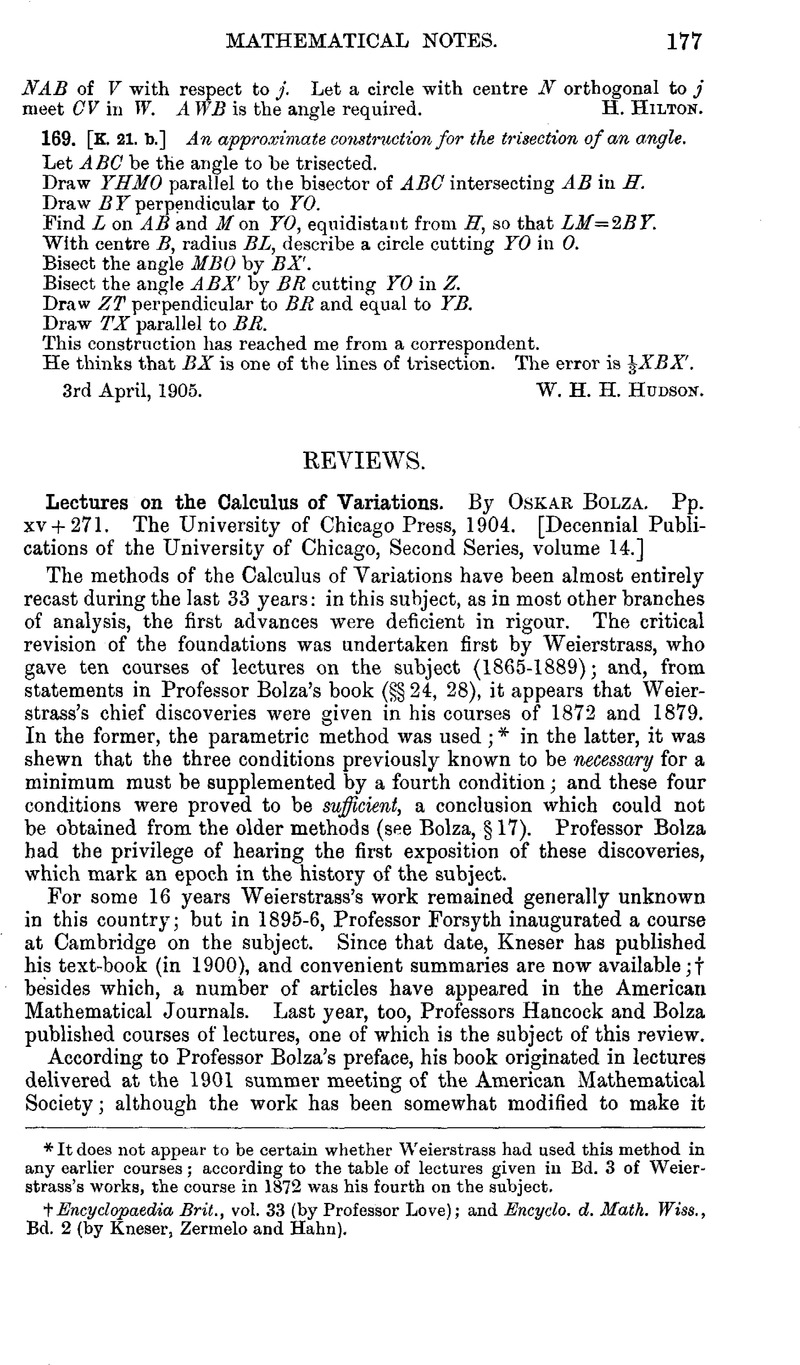No CrossRef data available.
Published online by Cambridge University Press: 03 November 2016

page 177 note * It does not appear to be certain whether Weierstrass had used this method in any earlier courses; according to the table of lectures given in Bd. 3 of Weierstrass’s works, the course in 1872 was his fourth on the subject.
page 177 note † Encyclopaedia Brit., vol. 33 (by Professor Love); and Encyclo. d. Math. Wiss., Bd. 2 (by Kneser, Zermelo and Hahn).
page 178 note * Compare Hedrick, E. R., Bull. Amer. Math. Soc., vol. 9, 1902, p. 23 Google Scholar. Note that necessary and sufficient conditions are known for the integral (2), but not for (1).
page 178 note † I quote from a review by Stäckel, in the Archiv der Math. u. Phys., Bd. 8, 1904, p. 259 Google Scholar: “Nicht der ist ein treuer Schüler von Weierstrass, wer kritiklos hinnimmt, was dieser gelehrt hat, sondern wer bemüht ist, nach seinen Kräften die Teile der mathematischen Wissenschaft zu fördern, die dem Meister am Herzen lagen.”
page 178 note ‡ Here p(x, y) is a one-valued function of x, y, such that y′ = p(x, y) is a first integral of the differential equation of the problem arising from the integral (1).
page 179 note * Expressed analytically, the old assumption amounts to taking variations of the type ϵϕ(x), where ϵ is small and ϕ(x) is arbitrary, but does not contain ϵ. This would exclude ϵ sin (x/ϵ). Variations such as ϵϕ(x) are now called weak variations.
page 179 note † For, put y = x + ξ, where ξ is a continuous one valued function of x, which is zero for x = 0 and x = 1; then, after integration, we find that the first integral becomes
![]()
shewing that ξ = 0 makes the integral a minimum. But in the parametric form the same transformation gives
![]()
and, as x′ may now be negative, the minimum property no longer holds. In particular, consider the “curve” of zig-zag straight lines given by

This curve makes the value of the parametric integral – n; and hence, as n is not limited, the integral can have no minimum. Of course, on this curve, y is not a one-valued function of x.
page 180 note * I note, incidentally, that this value of y makes ![]() a minimum, if y is restricted to be a one-valued function of x. In fact, if we write
a minimum, if y is restricted to be a one-valued function of x. In fact, if we write
![]() arc tan (x tan θ) + ξ,
arc tan (x tan θ) + ξ,
ξ being subject to the same conditions as before, we find
![]() .
.
page 180 note † Their argument is that the integral
![]() .
.
taken through a volume on the boundary of which V is to have assigned values, must have a minimum because the subject of integration is never negative. Granting this assumption, the existence of a solution of the potential equation ΔV = 0, with given boundary-values can be deduced. But the same argument applies to Weierstrass’s example, for which the corresponding conclusions are wrong; because the integral has no minimum, neither has the differential equation a solution (with the given end-conditions).
page 180 note ‡ In his first account of the theory (Jahresbericht d. D, Math. Verein., Bd. 8, 1900, p. 184), Hilbert says: “Das folgende ist ein Versuch der Wiederbelebung des Dirichlet’schen Principe.”